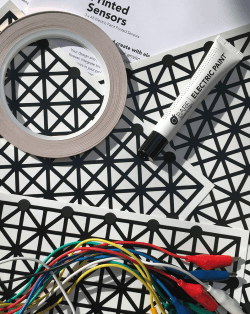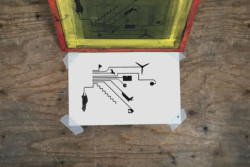Review: Touch Board Pro Kit
October 19, 2017
on
on

Interfacing for immediate interactivity
As the kit describes itself, it marries programmed electronics (Atmel ATmega32U4) and touch sensors for immediate interactivity. “Make interactive projects in no time, whether you’re a designer, engineer, or creative” says the sub-title of the instructions.This does not come from the USA nor China, but from London. The company Bare Conductive works with ‘electric paint’ or conductive ink which enables electr(on)ic circuits to be made on unorthodox media. So it is logical that our kit (click the photos to enlarge) contains – firstly but not only – some conductive paint, in a tube and in a pot, a roll of self-adhesive copper tape and some printed sensors.
If like me you can easily imagine what the ink and adhesive copper tape are for, the A5 Printed Sensors will no doubt leave you perplexed.
These A5 Printed Sensors

The conductive ink is a type of water-based paint, non-toxic, which lets you create tracks, contacts, switches etc., on any sort of material, from glass to fabric, by leather and cardboard. Like any ordinary paint, it can be applied easily with all kinds of brushes, stencils, silkscreen or directly from the tube. It dries quite quickly.
Surface Resistance
One must take account of the limitations imposed by the intrinsic resistance of this unique conductor. Higher than that of our more common conductors, it does not take high currents well. The recommended range of voltage is up to 12 V DC, but is that a restriction?It is interesting to note that the resistance of the conductive paint (55 Ω/square (printed) and 32 Ω/square (brushed)) is not related to the painted area in the same way as the resistance of a more conventional materials is related to its dimensions. This leads to some interesting experiments; it is well described in the application notes.
Color and rigidity

and symbols, screen-printed using
the conductive ink.
Its mechanical flexibility will depend on the thickness of the layer, its composition and the nature of the support medium.
The color of the ink is black, but once it has dried it may be covered with any acrylic paint of a different color, which can also act as an insulator between layers of conductive ink. This opens unlimited possibilities (but not that of inkjet printing).
Read full article
Hide full article


Discussion (0 comments)